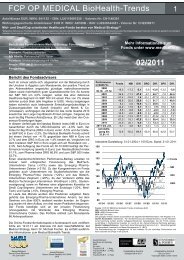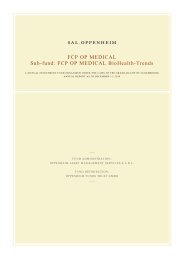FCP OP MEDICAL BioHe@lth-Trends - medical.lu
FCP OP MEDICAL BioHe@lth-Trends - medical.lu
FCP OP MEDICAL BioHe@lth-Trends - medical.lu
You also want an ePaper? Increase the reach of your titles
YUMPU automatically turns print PDFs into web optimized ePapers that Google loves.
Development of the Capital Markets in the Period under Review<br />
significantly strengthened the negotiating hand of the Small- and<br />
Mid Cap biotech companies and may be interpreted as a potential<br />
va<strong>lu</strong>e-adding factor.<br />
In terms of the va<strong>lu</strong>ations, the limits between Big Pharma and Big<br />
Biotech become visibly b<strong>lu</strong>rred. Six biotech companies already<br />
have market capitalisations in excess of USD 10 billion, with two<br />
– Amgen and Genentech – are va<strong>lu</strong>ed at around USD 90 billion.<br />
The price-sales ratios of the large biotech companies are in the 6 to<br />
10 range.<br />
Speciality Pharma<br />
Speciality Pharma companies concentrate for the most<br />
part geographically on one region, e.g. North America or<br />
Europe. They cover few, i.e. two or three, therapy areas, focusing<br />
primarily on sales and marketing. Other key functions are<br />
outsourced. In the 1990s, this type of company became<br />
increasingly important in the drugs market as Big Pharma<br />
concentrated increasingly on so-called blockbuster products for the<br />
wider market at the expense of the potential in many special<br />
indication areas. The younger speciality pharmaceutical companies<br />
were able to take full advantage of these gaps in the market,<br />
licensing-in and successfully marketing, in particular, innovative<br />
<strong>medical</strong> preparations for fast-growing specialist areas such as<br />
dermatology, ophthalmology, gastroenterology, gynaecology and<br />
neurology.<br />
The advantages of these niche segments are that there is reduced<br />
competition, and therefore lower marketing costs and, in most<br />
cases, less price sensitivity. This means that, with lower sales<br />
vo<strong>lu</strong>mes, specialist companies can achieve above-average profits.<br />
In recent times, because of the increasing price competition,<br />
generic product companies in particular have been expanding their<br />
business model towards patented specialist drugs.<br />
Drug delivery companies<br />
The drug delivery companies represent a further sub-segment in<br />
the drugs sector. By developing new types of administering<br />
technologies, known as drug delivery, these companies are making<br />
a substantial contribution to progress in the field of drugs.<br />
According to a study carried out by Nomura, the number of drugs<br />
that employ innovative release technologies – such as delayed<br />
release of active agents, transdermal plaster systems and inhalable<br />
active agent preparations – has increased substantially. They now<br />
account for 13% of drug sales worldwide.<br />
According to the Institute for Medicines Research, about 15% of<br />
pharmaceutical research budgets is spent on projects using drug<br />
delivery technologies. In biotechnology, in particular, these<br />
procedures are used to extend the duration of the effect of the drug<br />
(e.g. deposit injections) or as an alternative to injections (e.g.<br />
administration as a nasal spray). Since drug delivery products, in<br />
contrast with research into new drugs, are based for the most part<br />
on known substances, a shorter development time and lower<br />
development risk can make this area of the healthcare sector a<br />
particularly attractive one.<br />
Medical technology<br />
In addition to the drugs, <strong>medical</strong> technology is the second-largest<br />
product area in the healthcare sector. The segment is relatively<br />
heterogeneous, comprising hospital products (e.g. syringes and<br />
catheters), laboratory equipment (inc<strong>lu</strong>ding for in vitro<br />
diagnostics), complicated <strong>medical</strong> products (e.g. defibrillators) and<br />
4<br />
a broad range of diagnostics equipment such as nuclear magnetic<br />
resonance tomographs.<br />
Technical progress in areas, such as microelectronics and materials<br />
technology is making a significant contribution to the increasing<br />
importance of new products in the field of <strong>medical</strong> technology used<br />
in the treatment of impaired bodily functions or illness conditions.<br />
So, for example, in many sectors – inc<strong>lu</strong>ding cardiology and<br />
neurology – <strong>medical</strong> technology in the form of active implants<br />
such as heart pacemakers and neurostimulators are competing with<br />
more traditional drug-based forms of therapy. Medical technology<br />
has enjoyed particular success recently in the combination of<br />
medicines and drugs, such as drug-releasing stents for preventing<br />
arteriosclerotic vascular obliterations. Medical technology in the<br />
field of passive implants such as artificial hip and knee joints is<br />
currently without competition. Moreover, new image-based<br />
procedures provide improved diagnosis facilities and increased<br />
application of minimally invasive surgical techniques.<br />
The development period for many Medtech products is far shorter<br />
than it is for drugs and, thanks to ongoing technological<br />
improvements, there are no problems associated with generic<br />
products. The rapidly growing worldwide Medtech market is<br />
estimated at more than USD 230 billion (source: Oppenheim<br />
Research, 2004).<br />
Healthcare information technologies (e-health)<br />
Health costs are growing more quickly than gross national<br />
products, while at the same time the efficiency of the health<br />
economy is trailing far behind that of the rest of the economy<br />
(Information Week Study 2004). One response to this dilemma<br />
therefore lies in the call for increased use of modern information<br />
technologies in the health sector. The American government is at<br />
the forefront of this initiative, investing some USD 125 million<br />
over the next few years to promote the application of information<br />
technologies in the healthcare sector. Similar initiatives are also<br />
being pursued in Europe.<br />
The group of e-health companies is very heterogeneous, as<br />
information technology can be used in many and varied ways to<br />
resolve a host of different tasks. The companies have set<br />
themselves the overall goal of improving administration,<br />
coordination, documentation and therapy management – inc<strong>lu</strong>ding<br />
monitoring success in hospitals, general practices and other care<br />
facilities – through the use of modern information and Internet<br />
technology.<br />
Apart from efficiency, the lack of up-to-date information<br />
technology also has an adverse impact on the quality of <strong>medical</strong><br />
care. The Institute of Medicine, for example, has established that<br />
mistakes in <strong>medical</strong> treatment could account for as many as 98,000<br />
unnecessary deaths in the USA. This makes avoidable <strong>medical</strong><br />
mistakes the eighth most frequent cause of death in the USA. The<br />
consequential financial costs of such mistakes are estimated at<br />
USD 8 billion a year.<br />
As a result, health insurance companies are becoming increasingly<br />
interested in the introduction of information technology. In<br />
particular, electronic patient files in combination with electronic<br />
prescription software promises to make a major contribution to<br />
improved quality and increased efficiency, since by taking into<br />
account all illness-related data both erroneous drug prescriptions<br />
and duplicate examinations can be avoided.





